Students can Download 2nd PUC Biology Model Question Paper 2 with Answers, Karnataka 2nd PUC Biology Model Question Papers with Answers helps you to revise the complete Karnataka State Board Syllabus and score more marks in your examinations.
Karnataka 2nd PUC Biology Model Question Paper 2 with Answers
Time: 3.15 Hours
Max Marks: 70
General Instructions:
- This question paper consists of four parts A, B, C and D. Part D consists of two parts, Section – I and Section – II.
- All the parts are Compulsory.
- Draw diagrams wherever necessary. Unlabelled diagrams or illustrations do not attract any marks.
Part – A
I. Answer the following questions in One Word or One Sentence each : ( 10 × 1 = 10 )
Question 1.
Name the hormone that induces rupturing of Graafian follicle.
Answer:
Luteinizing hormone (LH).
Question 2.
Sertoli cells are very much essential during spermatogenesis. Why?
Answer:
They provide necessary nutrition for the normal development of germ cells (sperms) during spermatogenesis.
Question 3.
Define convergent evolution.
Answer:
The development of functionally similar structures in unrelated organisms due their adaptation to a, similar environment.
![]()
Question 4.
Name the test conducted to confirm Typhoid fever.
Answer:
Widal test.
Question 5.
What is micro-propagation?
Answer:
Production of large number of plants through tissue culture within a short span of time.
Question 6.
What are Floes?
Answer:
Masses of bacteria associated with fungal filaments to form mesh like structures during secondary treatment of effluent is called floes.
Question 7.
Mention the uniqueness of DNA polymerase used in PCR.
Answer:
DNA polymerase is a thermostable enzyme obtained from thermus aquaticus bacterium isolated from hot springs.
Question 8.
Mention the reason behind auto – immune disease.
Answer:
It is an abnormal immune response, in which the immune system of the body fails to fairly distinguish its own cells from foreign cells and start destroying its own cells and molecules thinking them as foreign cells
OR
The disease resulting from self destruction of cells and molecules by the immune system of the body.
Question 9.
Why Western Ghats are considered as one of the biodiversity hot spots?
Answer:
It has high level of species richness.
OR
It has high degree of endemism.
![]()
Question 10.
“Some animals, if unable to migrate, might avoid the stress by escaping in time”. Justify the statement citing one example.
Answer:
Animals which are unable to migrate might suspend or slow down their metabolic activities to escape the stress in time.
OR
- Bears go into hibernation in winter.
- Some snails and fish enter in to aestivation in summer.
- Insects enter in to diapauses (Dormant stage in the development).
PART-B
II. Answer any FIVE of the following questions in 3 – 5 sentences each, wherever applicable : ( 5 × 2 = 10 )
Question 11.
What is parthenogenesis? Name an animal showing this.
Answer:
Parthenogenesis is a mode of sexual reproduction in which young ones develop from the egg without fertilization.
Example: In honey bees, haploid egg develops into haploid male without fertilization.
Question 12.
Differentiate between incomplete dominance and co dominance.
Answer:
Incomplete dominance
- Neither of the allele is completely dominant.
- Produces phenotype intermediate between the two.
Example: Pink flowers in Mirabilis jalapa
Co dominance
- Both the alleles are equally dominant.
- Both express side by side in heterozygous condition.
Example: AB blood group
Question 13.
“Darwin’s finches represent one of the best examples for adaptive radiation”. Comment.
Answer:
- The Galapagos Islands are home to 13 species of finches, which evolved on the Galapagos Island in isolation from other finches.
- They evolved from a single seed eating finches of the main island (south America).
- New species of finches evolved from the originally colonize the island provide unique example of adaptive radiation. Thus, supporting evolution.
![]()
Question 14.
Draw a neat labeled diagram of an antibody molecule.
Answer:
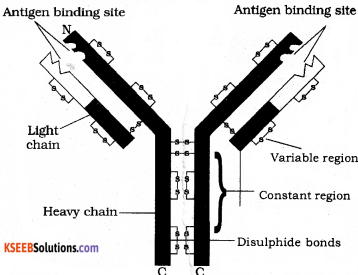
Question 15.
List the objectives of biofortification.
Answer:
Breeding crops with
- Higher levels of proteins, vitamins and minerals.
- Oil content and quality.
- Micronutrient and mineral content.
Question 16.
Draw a neat labelled diagram of sparged stirred tank bioreactor.
Answer:
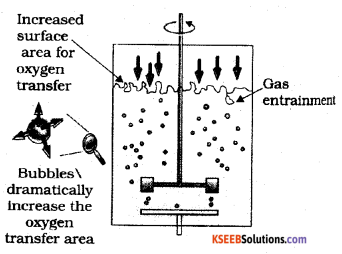
Question 17.
Write a note on Co – extinction.
Answer:
Extinction of one species invariably leads to extinction of another when they are associated with each other in an obligatory way.
Example : When host species is extinct, obligate parasites dependent on it also die.
![]()
Question 18.
“India is rich in genetic diversity”. Justify this statement by giving two examples.
Answer:
- It is one of the 12 mega diversity countries of the world.
- It accounts 8.1 % of the total specie s diversity of the world.
- It has around 167 species of cultivated plants and 320 wild relatives of crop plants.
- It is divided in to 10 biogeographic regions.
- It has recorded around 45.000 species of plants and twice the number of animal species.
Part – C
III. Answer any FIVE of the following Questions in 40*80 words each, wherever applicable. ( 5 × 3 = 15 )
Question 19.
Name the following:
i) ASexual reproductive structures of Hydra.
Answer:
External buds
ii) Vegetative propagules of Agave.
Answer:
Bulbils
iii) The plant that flowers once in twelve years.
Answer:
Bamboo
![]()
Question 20.
Differentiate between microsporo- genesis and megasporogenesis.
Answer:
Microsporogenesis
- It is the process of formation of microspores (pollen grains).
- It occurs within the microsporangium (pollen sac).
- It produces four haploid pollen grains.
- The microspores formed from microspore mother cell (MMC) form a tetrad of microspores.
- All the four microspores of a tetrad become functional producing four pollen grains.
Megasporogenesis
- It is the process of formation of megaspore (embryo sac).
- It occurs within the megasporangium (ovule).
- It produces one functional embryo sac.
- The megaspores formed from megaspore mother cell are arranged linearly.
- Of the four linearly arranged megaspores, the upper three megaspores degenerate and the remaining one becomes functional megaspore.
Question 21.
Write the pedigree analysis chart for myotonic dystrophy. Mention the importance of pedigree analysis.
Answer:
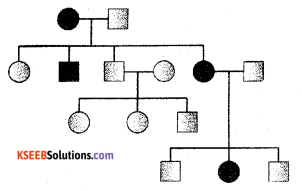
Importance of pedigree analysis
- It provides a strong tool which is used to trace inheritance of a specific traits and genetic disorders like haemophilia.
- It is used to trace the inheritance of Mendelian disorders like haemophilia, cystic fibrosis, sickle cell anaemia, colour blindness, phenyl ketonuria (PKU), thalassemia, etc.
- It also provides information about the dominant or recessive nature of the trait.
![]()
Question 22.
Write notes on Evolution according to Lamarck
Answer:
1. Internal vital force
All organisms tend to increase their body parts and size due to internal vital force.
2. Doctrines of desires and appetency
New organs or variations appear due to wish.
3. Use and disuse of organs
The development of organs and their use are proportional to the activities of the organs.
4. Inheritance of acquired characters
New characters or variations acquired by an organism in its life time are preserved and pass on to future generations.
5. Speciation
Variations accumulate in organisms over generations and lead to speciation.
b) Write the scientific name of man like primate who probably lived in East African grasslands about 3-4 million years ago.
Answer:
Ramapithecus
Question 23.
Describe the effects of drug abuse.
Answer:
The harmful effects of alcohol or drug abuse are as follows:
- The immediate adverse effects of drugs and alcohol abuse are manifested in the form of reckless . behavior, vandalism and violence.
- In case of excessive doses of drugs coma and death may results due to respiratory failure, heart failure or cerebral hemorrhage.
- Drop in academic performance, lack of interest in personal hygiene, withdrawal, isolation, depression, fatigue, aggressive and rebellious behavior, deteriorating relationship with family and friends, lack of interest in hobbies, change in sleeping and eating habits, fluctuations in weight, appetite etc.
- If an abuser is unable to get money to buy drugs or alcohol he or she may turn to stealing, alcohol and drug addiction becomes the cause of mental and financial distress to his or her family or friends.
- Sharing of infected needles and syringes during intravenous administration of drugs is responsible for spread of infections like AIDS, Hepatitis B from person to person.
- The chronic use of drugs and alcohol damages nervous system and liver cirrhosis, use of drugs or alcohol during pregnancy adversely affect the foetus.
- The misuse of anabolic steroids, narcotics, analgesics , diuretics and certain hormones used by sports persons to enhance their performance results in serious ill effects.
Question 24.
Write a note on downstream processing.
Answer:
The various processes involved in the separation, purification and recovery of biosynthetic products, particularly pharmaceuticals, from natural sources such as animal or plant tissue or fermentation broth or other industrial processes are collectively called downstream processing.
Stages in Downstream Processing
Removal of insolubles → Product Isolation → Product Purification → Product Polishing.
Question 25.
Draw the schematic representation of phosphorous cycle.
Question 26.
Define ecological succession. Mention two types of based on succession in plants.
Answer:
The natural process by which different groups of biotic communities colonize the same area over a period of time due to replacement of one community by the other in an orderly sequence till a stable community develops over the area is called ecological succession.
Ecological succession is of two main types namely
- Primary succession.
- Secondary succession.
Part – D
Section – I
IV. Answer any FOUR of the following questions on 200 – 250 words each, wherever applicable. ( 4 × 5 = 20 )
Question 27.
Explain how some plants are adapted for achieving pollination through wind. How Vallisneria and Seagrasses achieve pollination?
Answer:
Pollination brought about by the agency of wind is called anemophily.
Adaptation in anemophillous flowers to achieve pollination.
- Comparatively small and unattractive.
- Anthers produce large number of pollen grains to ensure fertilization.
- Flowers do not secrete scent or nector.
- Produce anthers with long filament so that anther comes out of the flower and expose to the wind.
- Stigma is large and has feathery surface to receive pollen grains from the wind.
- Pollen grains are light and dry in nature and some with wings, there by, easily carried by wind.
In Vallisneria, the female flower reach the surface of water by the long stalk and the male flowers or pollen grains are released on to the surface of water. They are carried passively by water currents, some of them eventually reach the female flowers and the stigma.
In another group of water pollinated plants such as seagrasses, female flowers remain submerged in water and the pollen grains are- released inside the water. Pollen grains in many such species are long, ribbon like and they are carried passively inside the water; some of them reach the stigma and achieve pollination. In most of the water – pollinated species, pollen grains are protected from wetting by a mucilaginous covering.
Question 28.
a) Draw a neat labeled diagram of sectional view of seminiferous tubule.
Answer:
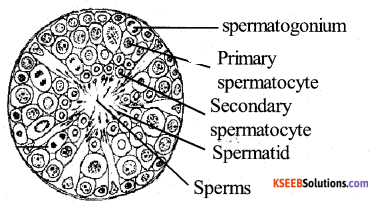
b) Differentiate between spermato genesis and spermiogenesis.
Answer:
Spermatogenesis
- It is the process of formation of sperms.
- It produces non motile spermatids.
Spermiogenesis
- It is the process of transformation of spermatids in to sperms.
- It produces motile sperms.
![]()
Question 29.
What is infertility? How infertility is treated by assisted reproductive technologies like IVF – ET and ZIFT?
Answer:
1. Inability of a couple to produce children in spite of unprotected sexual cohabitation
OR
2. Inability of a couple to conceive or produce children even after 2 years of unprotected sexual cohabitation.
1. In vitro fertilization and embryo transfer (IVF-ET)
In this technique egg cells are fertilized by sperm (usually 100,000 sperm / ml) outside the body in almost similar conditions as that in the body.
In this process Ova from the wife or donor female and sperm from husband or donor male are allowed to fuse in shallow containers called Petri dishes. (Made of glass or plastic resins) under laboratory condition.
The fertilized egg (zygote) is then transferred to the patient’s uterus, is this called embryo transfer (E.T.), Where she provides suitable conditions for the development of embryo. The baby born by this technique is called test tube baby.
2. ZIFT ( Zygote intra fallopian transfer)
Zygote or early embryo up to eight blastoineres is transferred into the fallopian tube.
Question 30.
What are the salient features of double helical structure of DNA?
Answer:
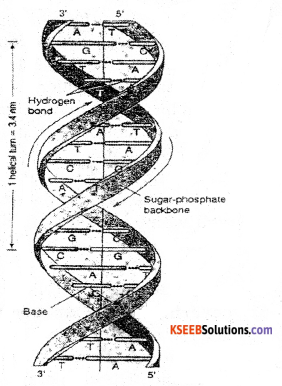
The duplex model of DNA was proposed by J.D Watson and F.H.C Crick based on the x- ray diffraction data obtained by Rosalind Franklin and Wilkins J (1953). Watson and Crick along with Wilkins were awarded Noble Prize in 1962.
According to this model:
- The DNA is composed of two polynucleotide chains; which are complementary and antiparallel. i.e, if one strand runs in 51 – 31 direction other strand runs in 31– 51 direction.
- The two polynucleotide chains are spirally coiled around each other in a regular manner; so as to give the appearance of a twisted ladder or spiral staircase.
- The two chains are held together by hydrogen bonds between complementary purine and Pyrimidine bases.
- The phosphate and deoxyribose sugar units connected with phosphodiester bonds are found on the periphery of the helix where as purine and pyrimidine nitrogen bases occur in the center.
- DNA nucleotide strand is formed by alternatively arranged phosphate and sugar groups.
- Base pairing is specific and complementary to each other.
- The purine adenine pairs with pyrimidine thymine by two hydrogen bonds (A = T).
- The purine guanine pairs with pyrimidine cytosine by three hydrogen bonds (CΞG).
![]()
Question 31.
Explain Meselson and Stahl’s experiment which proved that DNA replicates semi – conservatively.
Answer:
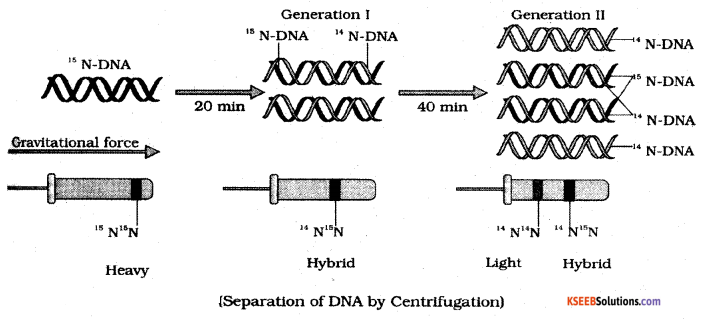
Meselson and Stahl conducted experiments on E.coli to prove that DNA replication is semi conservative.
- They grew E.coli cells in a culture medium containing radioactive isotopes N15 (NH4cl). The 15N was incorporated into the newly synthesized DNA and other nitrogen containing compounds.
- Bacteria labeled with 15N are transferred into a medium containing normal 14NH4cl.
- The analysis was done after every generation at regular intervals.
- The DNA samples were separated by centrifugation on CSCl2 gradient.
- The hybrid DNA separated from fresh generations possesses one heavier strand contributed by parental with 15N isotope which is radioactive and lighter strand is newly synthesized with 14N isotope, is non-radioactive.
- The DNA of the second generation showed that in one DNA molecule one strand was radioactive (15N) and other was non radioactive (14N). Whereas both the strands of other DNA molecule were non¬radioactive (14N).
- It is clear that the DNA of the first generation is intermediate it contains both 15N and 14N.
- In the second generation there were two types of DNA one heavier DNA with 15N and 14N isotopes while the lighter DNA with 15N and 14N, the ratios of two types of DNA was 50:50.
- In the third generation the ratio of intermediate (15N and 14N) was reduced from 50% to 25% while the lighter fraction (14N and 14N) increased from (50% – 75%).
- In the 4th generation the percentage of intermediate still reduced to 12.5% while that of lighter fraction increased from 75% to 87.5%.
- These experiments prove that DNA shows semi conservative replication.
Question 32.
Discuss the contribution of Sutton and Boveri by making a comparison between the behaviour of chromosomes and genes during meiosis, to explain Mendel’s Laws.
Answer:
- Chromosomal theory of inheritance was proposed by Walter Sutton and Theodore Boveri (1902).
- It states that genes are located in the chromosomes and they segregate and assort independently during meiosis -1 and come together during fertilization along with chromosomes.
- Chromosomal theory of Sutton and Boveri explained that chromosomes are the carriers of genes and are the basis for Mendelian segregation and independent assortment.
- Chromosomes segregate during gametogenesis due to meiosis like Mendelian factors (Genes). These gametes become haploid; the diploid nature is returned in zygote due to random fertilization.
They noted that the behavior of Mendelian factors (genes) was parallel to the behavior of chromosomes (Sutton chromosomes) during meiosis as mentioned below.
- Both genes and chromosomes occur in pairs.
- Both segregate at the time of gamete formation.
- Both genes and chromosomes show independent assortment.
Section – II
Answer any THREE of the following questions in 200 – 250 words each, wherever applicable. ( 3 × 5 = 15 )
Question 33.
Explain how green revolution in India was achieved by developing high yielding varieties of Rice, wheat, sugarcane and millets. What was the aim behind developing high yielding varieties of Rice, wheat, sugarcane and millets. What was the aim behind developing the cow pea variety, “Pusa comal”?
Answer:
India is mainly an agricultural country. Agriculture accounts for approximately 33 per cent of India’s GDP and employs nearly 62 per cent of the population. The development of several high yielding varieties of wheat and rice in the mid – 1960s., as a result of various plant breeding techniques led to dramatic increase in food production in our country. This phase is often referred to as the green revolution.
Wheat and Rice :
In 1963, several semi dwarf varieties of wheat such as Sonalika and Kalyan Sona, which were high yielding and disease resistant, were introduced all over the wheat – growing belt of India.
Semi – dwarf rice semi dwarf varieties of wheat were derived from IR – 8, (developed at International Rice Reasearch Institute (IRRI), Philippines) and Taichung Native – 1 (from Taiwan). The derivatives were introduced in 1966. Later better – yielding semi – dwarf varieties Jaya and Ratna were developed in India.
Sugar cane :
Saccharum barberi was originally grown in north India, but had poor sugar content and yield. Tropical canes grown in south India Saccharum officinarum had thicker stems and higher sugar content but did not grow well in north India. These two species were successfully crossed to get sugar cane varieties combining the desirable qualities of high yield, thick stems, high sugar and ability to grow in the sugar cane areas of north India.
Millets:
Hybrid maize, jowar and bajra have been successfully developed in India. Hybrid breeding have led to the development of several high yielding varieties resistant to water stress.
Cow pea (Pusa comal) is a hybrid variety developed by conventional breeding methods such as hybridization and selection. It is made resistant to blight disease caused by bacteria.
![]()
Question 34.
“Genetically modified plants can reduce the use of chemical pesticides”. Justify the statement. Write a note each on Bt toxin and Bt cotton.
Answer:
Genetically modified crops have greatly reduced the use of chemical insecticides as they are made resistant to various pathogens through genetic engineering.
Bt toxins
- These are toxic insecticidal proteins produced by a soil bacterium Bacillus thuringiensis
- It produces crystalline proteins (cry proteins).they form crystalline inclusions in the bacterial spores.
- These spores kill certain groups of insects such as lepidopterans (tobacco worm, bud worm,army worm), coleopterans (beetles) and dipterans (flies and mosquitoes)
- Cry proteins dissolve in the alkaline juices of the mid gut.
- They bind to receptors present in the brush border of mid gut epithelial cells of the insects.
- The brush border membrane develops pores.
- These pores allow influx of ions and water, which causes their swelling and eventual death.
Bt- cotton:
- It is a transgenic plant produced by cloning BT (Bacillus thuringiensis) genes isolated from BaciUus thuriengiensis bacterium.
- It is resistant to cotton boll worms and stem borer which feed on them.
- Bt genes produce proteins (Crystal Protein-cry I AC, cry IIAB) that kills the insects.
- Hence cry-genes have been introduced in plants to produce crystal proteins as Protoxin (inactive toxin), which is converted to toxins in alkaline medium (i.e. in the gut of insects) and cause death of the insect larva.
Question 35.
a) Describe the roles of:
i) Microbes in biogas production
ii) Mycorrhiza as biofertilizer
b) Name a free – living bacterium that is used as biofertilizer.
i) Role of microbes in biogas production .
Answer:
- Biogas is a mixture of gases produced by the microbial activity of methane producing bacteria collectively called methanogens.
- Methanobacterium is one such common methane producing bacteria found in the anaerobic kludges during sewage treatment.
- In the first stage aerobic bacteria convert complex organic substances present in the biological wastes in to simple molecules.
- These molecules are degraded anaerobically to produce organic acids like acetic acids.
- Methanogens under anaerobic conditions convert acetic acid in to methane and carbon dioxide.
ii) Micorrhiza as biofertilizers
1. It is a symbiotic association of fungus with the roots of higher plants.
Example : Gomus species form mycorrhiza; Fungal symbiont absorbs phosphorus from soil and made available to plants.
2. This association also makes the plant to show resistance to root borne pathogens, tolerance to salinity and drought thereby increase in growth and development.
b) Name a free – living bacterium that is used as biofertilizer.
Answer:
Azotobacter or Azospirillium are free living bacteria fix atmospheric nitrogen.
![]()
Question 36.
a) Explain how Mediterranean orchid achieve pollination.
Answer:
Orchids show diversity of floral patterns to attract the right pollinator insect and ensure guaranteed pollination by it. The Mediterranean orchid Ophrys employs sexual deceit to get pollination done by a species of bee, one petal of flowers show resemblance to the female of the bee in size and colour markings, the male bee is attracted to what it perceives as a female pseudo copulates with the flower and during that process is dusted with pollen from the flower, when the same bee pseudo copulates with another flower it transfers pollen to it and thus, pollinates the flower.
b) Draw a graph showing biome distribution with respect to annual temperature and preciptiation.
Answer:

![]()
Question 37.
Describe the participation of people in the conservation of forests in India by taking Bishnoi community incident and Chipko movement as examples. Add a note on Joint Forest Management.
Answer:
A case study of people’s participation in forest conservation
- A king of Jodhpur wanted to arrange wood for his new palace in 1731.
- Few Bishnois hugged the trees and asked to cut them first rather than cutting trees. 365 persons lost their lives in this act
- A small temple is now present there in remembrance of this act
- Amrita Devi Bishnoi Wild Life Protection Award is instituted for individuals of rural areas who take keen interest in protecting wild life.
Chipko movement
- It was started by local women of Garhwal,
- They hugged the trees to protect them from the axes of contractors.
Joint forest management (JFM)
- Started by Government of India in 1980
- To involve local communities with the government for protecting and managing forests, inturn communities get forest products for their encouragement.